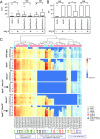Phospholipid membranes drive abdominal aortic aneurysm development through stimulating coagulation factor activity
- PMID: 30944221
- PMCID: PMC6475397
- DOI: 10.1073/pnas.1814409116
Phospholipid membranes drive abdominal aortic aneurysm development through stimulating coagulation factor activity
Abstract
Abdominal aortic aneurysm (AAA) is an inflammatory vascular disease with high mortality and limited treatment options. How blood lipids regulate AAA development is unknown. Here lipidomics and genetic models demonstrate a central role for procoagulant enzymatically oxidized phospholipids (eoxPL) in regulating AAA. Specifically, through activating coagulation, eoxPL either promoted or inhibited AAA depending on tissue localization. Ang II administration to ApoE-/- mice increased intravascular coagulation during AAA development. Lipidomics revealed large numbers of eoxPL formed within mouse and human AAA lesions. Deletion of eoxPL-generating enzymes (Alox12 or Alox15) or administration of the factor Xa inhibitor rivaroxaban significantly reduced AAA. Alox-deficient mice displayed constitutively dysregulated hemostasis, including a consumptive coagulopathy, characterized by compensatory increase in prothrombotic aminophospholipids (aPL) in circulating cell membranes. Intravenously administered procoagulant PL caused clotting factor activation and depletion, induced a bleeding defect, and significantly reduced AAA development. These data suggest that Alox deletion reduces AAA through diverting coagulation away from the vessel wall due to eoxPL deficiency, instead activating clotting factor consumption and depletion in the circulation. In mouse whole blood, ∼44 eoxPL molecular species formed within minutes of clot initiation. These were significantly elevated with ApoE-/- deletion, and many were absent in Alox-/- mice, identifying specific eoxPL that modulate AAA. Correlation networks demonstrated eoxPL belonged to subfamilies defined by oxylipin composition. Thus, procoagulant PL regulate AAA development through complex interactions with clotting factors. Modulation of the delicate balance between bleeding and thrombosis within either the vessel wall or circulation was revealed that can either drive or prevent disease development.
Keywords: aneurysm; angiotensin; lipid; lipoxygenase; phospholipid.
Copyright © 2019 the Author(s). Published by PNAS.
Conflict of interest statement
The authors declare no conflict of interest.
Figures





References
-
- McPhee JT, Hill JS, Eslami MH. The impact of gender on presentation, therapy, and mortality of abdominal aortic aneurysm in the United States, 2001-2004. J Vasc Surg. 2007;45:891–899. - PubMed
-
- Ashton HA, et al. Multicentre Aneurysm Screening Study Group The Multicentre Aneurysm Screening Study (MASS) into the effect of abdominal aortic aneurysm screening on mortality in men: A randomised controlled trial. Lancet. 2002;360:1531–1539. - PubMed
-
- Bailey MA, et al. Plasma thrombin-antithrombin complex, prothrombin fragments 1 and 2, and D-dimer levels are elevated after endovascular but not open repair of infrarenal abdominal aortic aneurysm. J Vasc Surg. 2013;57:1512–1518. - PubMed
-
- Loeffen R, Spronk HM, ten Cate H. The impact of blood coagulability on atherosclerosis and cardiovascular disease. J Thromb Haemost. 2012;10:1207–1216. - PubMed
Publication types
MeSH terms
Substances
Grants and funding
- RG/12/5/29576/BHF_/British Heart Foundation/United Kingdom
- 203014/Z/16/Z/WT_/Wellcome Trust/United Kingdom
- 094143/Z/10/Z/WT_/Wellcome Trust/United Kingdom
- WT_/Wellcome Trust/United Kingdom
- RG/13/1/30181/BHF_/British Heart Foundation/United Kingdom
- RG/17/10/32859/BHF_/British Heart Foundation/United Kingdom
- RG/12/11/29815/BHF_/British Heart Foundation/United Kingdom
- RG/15/10/31485/BHF_/British Heart Foundation/United Kingdom
- CH/16/1/32013/BHF_/British Heart Foundation/United Kingdom
- RG/07/003/23133/BHF_/British Heart Foundation/United Kingdom
- FS/16/20/32005/BHF_/British Heart Foundation/United Kingdom
LinkOut - more resources
Full Text Sources
Molecular Biology Databases
Miscellaneous

